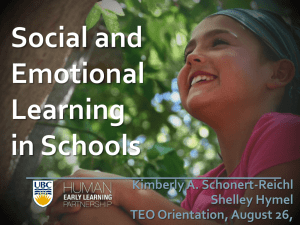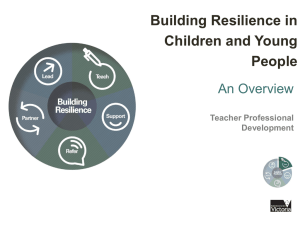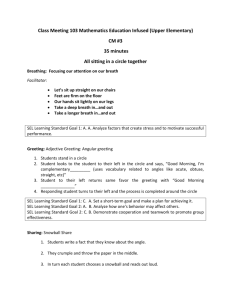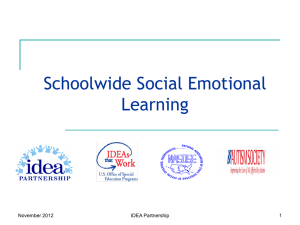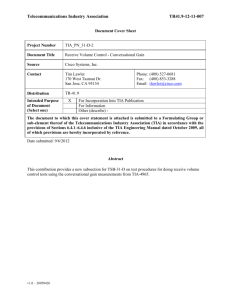PowerPoint file Social and Emotional Learning
advertisement
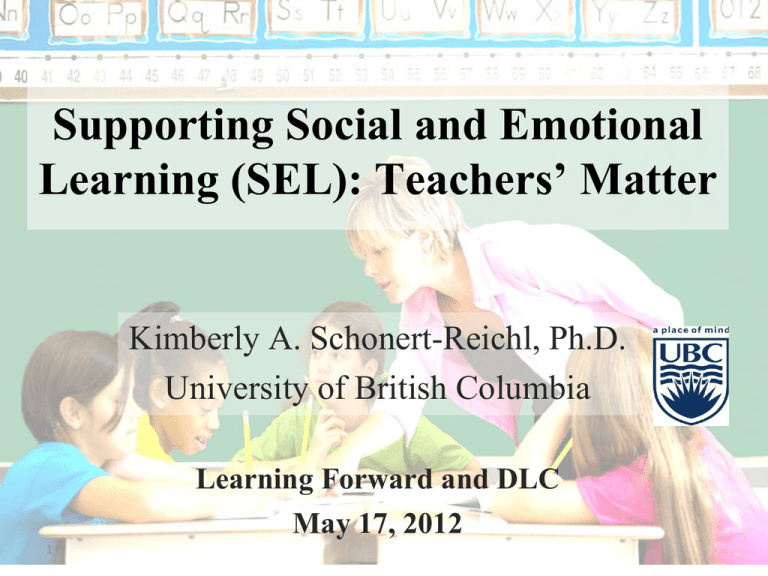
Supporting Social and Emotional Learning (SEL): Teachers’ Matter Kimberly A. Schonert-Reichl, Ph.D. University of British Columbia Learning Forward and DLC May 17, 2012 1 In referring to important characteristics in school culture . . . “among the most salient are the quality of relationships among students, the quality of students relationships to teachers and their relationship with the school.” (HigginsD’Alessandro & Sadh, 1997, p. 556) CASEL Heuristic Framework Healthy Relationships Effective SEL Implementation Self-Awareness Responsible SelfCASEL Management Five Core DomainsDecision- Making Effective Classroom Management of S-E Competence Social Awareness Relationship Skills Instructional Support Academic, Achievement, Behavioral, and Emotional Health School & Community Context; District, State & Federal Policy Social and Emotional Competencies Classroom Context: Climate and Interactions Teacher Social and Emotional Competence & Pedagogical Skills The Prosocial Classroom: A Model of Teacher Social and Emotional Competence and Classroom and Child Outcomes Healthy Teacher/Student Relationships Teachers’ Social & Emotional Skills & Well Being Effective classroom management skills Healthy Classroom Climate Student Social, emotional & academic outcomes Effective SEL implementation School/Community Context Factors Jennings & Greenberg, 2009 The Burnout Cascade Emotional Exhaustion De-personalization Lack of Accomplishment 50% leave within first 5 years of teaching (NEA, 2006) Depression and stress disorders at work account for more than 30% of all disability recorded at major Canadian corporations (2002) • Evidence supports the need for specialized professional development that promotes teachers’ social and emotional competence (SEC) and well-being to improve teachers’ emotional resilience and prevent emotional stress, thus reducing burnout and attrition and improving teachers’ capacity to provide well organized and instructionally and emotionally supportive classrooms, especially in high risk settings (Jennings & Greenberg, 2009). Supporting Teachers • Enhance regulatory processes that buffer against psychological distress • Promote flexibility and self-reflection • Overcome the tendency to make automatic, reactive appraisals of student behavior that contribute to emotional exhaustion • Improve SEL program implementation quality SMART Only: Positive Effects on Teaching • Made me more compassionate and kinder to little kids. • More encouraging [to students]; before wasn’t aware of present moment. • Try to think and realize what I need to do and pick one goal and accomplish that in the classroom. 14 SMART Only • I have noticed if I’m calm, my students are also calm. If students are really hyper, I just ask them to take 5 deep breaths. • Students tend to be a lot calmer. • Before I was more stressed; now, I deal with it and slow down; it impacts how the kids respond. 15 • Cultivating • Awareness • Resilience • Education CARE for Teachers • 30 Contact Hours over 4 weeks + booster • Emotion awareness – Didactic lessons on nature of emotion – Emotions in relation to teaching & learning – Experiential exercises to promote emotional awareness • Mindfulness Practice • Empathy & Compassion for self and other – Caring practice – Mindful listening exercises • Applications of these to teaching through discussion and role plays Sense of Self-Efficacy 7.3 7.2 7.1 7 6.9 Treatment 6.8 6.7 Control 6.6 6.5 6.4 6.3 Pre Post General Hurry 3.65 3.6 3.55 3.5 Treatment 3.45 Control 3.4 3.35 3.3 3.25 Pre Post Personal Accomplishment 4.85 4.8 4.75 4.7 4.65 Treatment 4.6 4.55 Control 4.5 4.45 4.4 4.35 Pre Post Daily Physical Symptoms 25 20 15 Treatment 10 Control 5 0 Pre Post Self-Regulation/De-centering “I’m much more calm. Even when I’m at home, drinking coffee, my mind’s not racing in a thousand different places, I’m just liking my coffee. I’ve learned how to just take things for what they are and not keep everything on my shoulders all the time. And because I’m not doing that anymore, that allows me to treat my kids better and address their needs better and try and teach them to be that way through my example.” Teacher Education Programs at UBC Teacher Education Programs at UBC Program Options Bachelor of Education Program Options • Elementary 12-Month Program • Elementary 2-Year Program • Middle Years Program • Secondary 12-Month Program • Secondary – Dual Degree: Bachelor of Science (Bsc) and Bachelor of Education (Bed) Native Indian Teacher Education Program (NITEP) Teacher Education Programs at UBC Elementary Cohort Options (Cont’d) UBC Teacher Ed. Program Arts-Based Community of Inquiry in Teacher Education (CITE) French Specialist French Language and Global Studies (FLAGS) Generalist Generalist Elementary Cohort Generalist - Intermediate Options for 12KG and Primary Month Program Problem-Based Learning (PBL) Social and Emotional Learning (SEL) Teaching English Language Learners (TELL) – July Start Self-Regulated Learning (SRL) Teaching from the Heart – July Start Fostering Resilience in Students: The Mindset of Teachers “The assumptions educators possess about themselves, their role as teachers, and their students’ capabilities play a significant role in determining expectations, teaching practices, and ultimately student happiness and success.” (p. 1) Brook s& Goldstein (2008). Canadian Journal of School Psychology 2648 Fostering Resilience in Students: The Mindset of Teachers (Cont’d) The Mindset of Effective Educators 2749 Brook s& Goldstein (2008). Canadian Journal of School Looking Ahead Implications for Practice Future Directions





